How about saying goodbye to winter early this year by breaking out the shovel and adding flowering plants that start blooming before spring starts? The following plants are drought-tolerant, easy to grow and well-adapted to the arid landscapes present throughout much of the western United States. Plant one, or all, and replace the winter doldrums with late-winter and spring color in the garden.
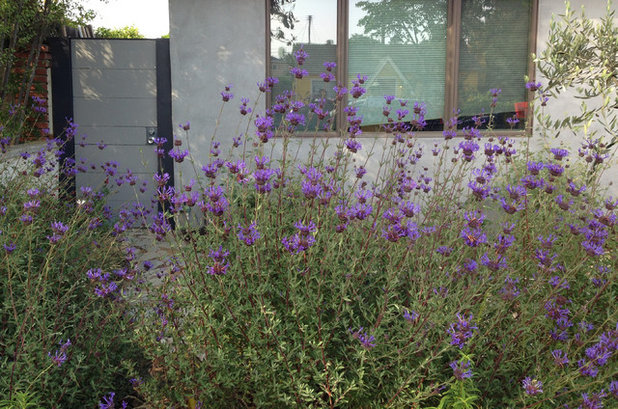 1. Cleveland Sage
1. Cleveland Sage(
Salvia clevelandii)
Native to Southern California and northern Baja California, Mexico
This California native shrub is transformed by spikes of purple flowers that rise above fragrant gray-green leaves. The flowers begin appearing in late winter, much to the delight of butterflies, hummingbirds and passers-by alike. In fall, a smaller flush of blooms occurs.
Cleveland sage has an open, informal growth habit best suited for naturally themed landscapes. It makes a lovely backdrop for shorter plants such as blackfoot daisy (
Melampodium leucanthum) and desert marigold (
Baileya multiradiata), which bloom at the same time.
Spent flower spikes make a nice addition to dried floral arrangements and bring the fragrance of the foliage indoors.
Where it will grow: Hardy to 10 degrees Fahrenheit, or minus 12 degrees Celsius (USDA Zone 8; find your zone)
Water requirement: Low; water every 10 days in spring and fall, weekly in summer, and every two weeks in winter.
Light requirement: Full sun; light afternoon shade in low-desert regions
Mature size: 3 to 5 feet tall and 5 to 8 feet wide
Planting notes: Plant in well-drained soil in full sun. Provide afternoon shade in desert gardens.
See how to grow Cleveland sage
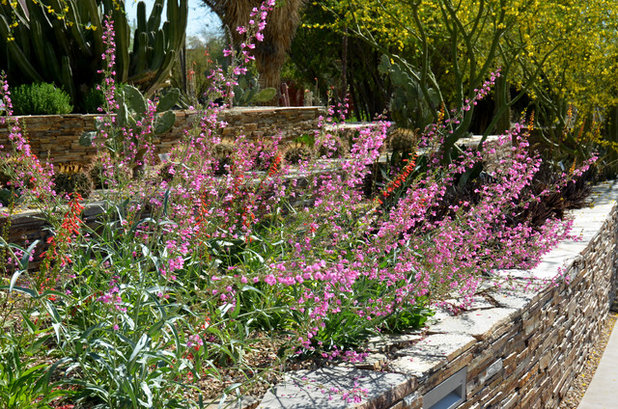
Noelle Johnson Landscape Consulting
2. Parry’s Penstemon(
Penstemon parryi)
Native to the low deserts of central Arizona and Sonora, Mexico
The pink flowering spikes of Parry’s penstemon command attention in the late winter and spring garden. While its flowers may look delicate, it thrives on neglect, as do many other penstemon species. The small trumpet-shaped flowers are borne above blue-gray leaves. To say that the flowers are attractive to hummingbirds is an understatement — the birds flock to this penstemon when it’s in flower.
This penstemon looks great planted next to boulders, in groups along a pathway or near plants such as angelita daisy (
Tetraneuris acaulis) and trailing lantana
(
Lantana montevidensis), which will take center stage once Parry’s penstemon stops flowering in late spring.
Cut back spent flower spikes to the base after the initial bloom, which will stimulate another flush of flowers.
Where it will grow: Hardy to 15 degrees Fahrenheit, or minus 9 degrees Celsius (Zone 8)
Water requirement: Water twice a month in spring and fall, and weekly in summer. In winter, it will survive on natural rainfall.
Light requirement: Full sun
Mature size: 1 foot tall and 1 to 2 feet wide; 3 feet tall when in flower
Planting notes: Plant in well-drained soil in full sun.
See how to grow Parry’s penstemon
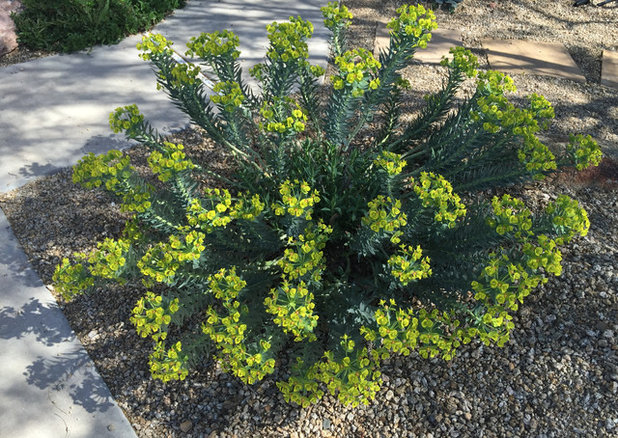
Noelle Johnson Landscape Consulting
3. Upright Myrtle Spurge(
Euphorbia rigida)
Native to the Mediterranean
Upright myrtle spurge’s succulent blue-gray foliage adds texture while visually cooling the landscape. Not willing to wait for the arrival of spring, flowers begin to appear before winter’s end, decorating the landscape with their cool yellow-green hues. Flowers turn an attractive light tan or orange as they begin to age. Prune away spent flowers at the base.
Upright myrtle spurge’s naturally mounded shape suits contemporary landscapes, whether planted in a straight line or staggered pattern. For a more natural appearance, scatter it throughout the landscape next to boulders.
Where it will grow: Hardy to minus 20 degrees Fahrenheit, or minus 29 degrees Celsius (Zone 5)
Water requirement: Water every two to three weeks in summer and monthly in winter in the absence of rain.
Light requirement: Full sun to filtered shade
Mature size: Up to 2 feet tall and 3 feet wide
Planting notes: Plant in well-drained soil in full sun or filtered shade.
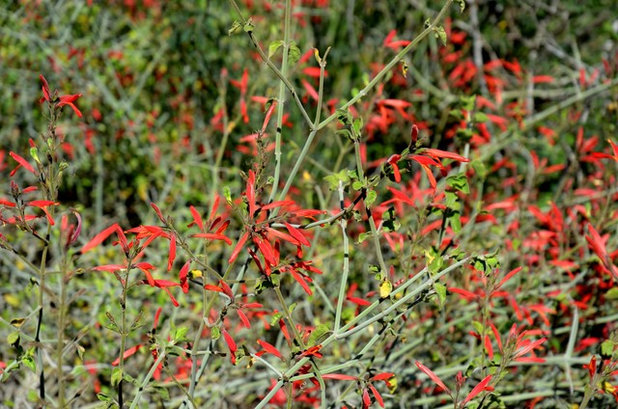
Noelle Johnson Landscape Consulting
4. Chuparosa(
Justicia californica)
Native to the Sonoran Desert of North America
Bright orange-red flowers burst forth from gray-green stems, adding a touch of warmth to the chilly winter and early-spring landscape. Chuparosa provides a welcome nectar source in late winter when not much else is in bloom, as the narrow trumpet-shaped flowers are the perfect size for hummingbirds. Flowers will continue to appear off and on throughout the year, but most blooms occur in late winter and spring. Heart-shaped leaves also contribute to the attractiveness of this desert native, but they may be absent in times of drought.
Chuparosa’s flowers are a great color contrast for yellow-flowering plants like brittlebush (
Encelia farinosa) and damianita (
Chrysactinia mexicana), and its open, sprawling growth habit looks best when used in natural landscape settings.
Where it will grow: Hardy to 20 degrees Fahrenheit, or minus 7 degrees Celsius (Zone 9)
Water requirement: Water every two to three weeks in winter and spring, and monthly in summer and fall.
Light requirement: Full sun to filtered shade
Mature size: 3 feet tall and 4 to 5 feet wide
Planting notes: Plant in well-drained soil in full sun or filtered shade.
See how to grow chuparosa
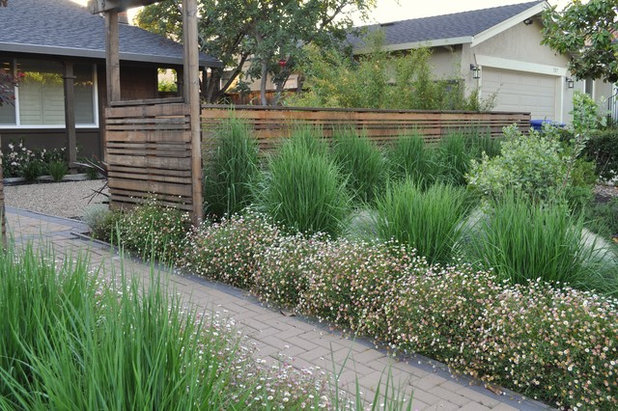
Huettl Landscape Architecture
5. Latin American Fleabane(
Erigeron karvinskianus)
Native to Mexico and Central America
This trailing ground cover heralds the approaching spring season with tiny daisies in shades of white and pink, creating a cottage garden feel. The flowers attract a number of beneficial insects, including bees. Summer heat will cause most flowering to cease, but cooler fall temperatures will bring back the daisies.
Narrow, dark green leaves form an attractive low-mounded growth habit that has several uses in the drought-tolerant landscape. Plant fleabane in a row alongside pathways or scatter alongside a dry creek bed. It looks nice alongside boulders or when planted in a bed filled with drought-tolerant perennials such as angelita daisy (
Tetraneuris acaulis), gaura (
Gaura lindheimeri) and Southwestern mock vervain (
Glandularia gooddingii). Fleabane also grows very well in containers and raised beds where it can trail over the edge, adding another decorative element to the drought-tolerant garden.
Where it will grow: Hardy to 15 degrees Fahrenheit, or minus 9 degrees Celsius (Zone 8)
Water requirement: Water every two weeks in spring and fall, every three weeks in winter, and every 10 days in summer. In low-desert zones, water every five to seven days in summer, and every 10 days in spring and fall.
Light requirement: Full sun to filtered shade; filtered shade in the low desert
Mature size: 1 to 2 feet tall and 2 to 3 feet wide
Planting notes: Plant in well-drained soil in full sun or filtered shade.
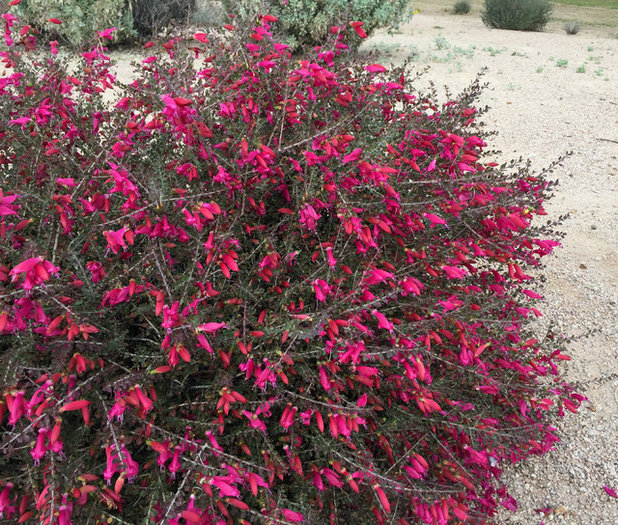
Noelle Johnson Landscape Consulting
6. Valentine Bush(
Eremophila maculata ‘Valentine’)
Native to Australia
The name of this brightly colored shrub says it all. Blossoms in shades of red and dark pink appear along the length of the stems in time for Valentine’s Day, sometimes at Christmas in zones 9 and above. Although this Australian native flowers just once a year, it has a long bloom period, ending in late spring.
Dark green foliage present year-round makes Valentine bush an excellent foundation plant, whether grown against walls, used to create a natural low hedge, or staggered in groups of three or five. Pair it with yellow-flowering feathery cassia (
Senna artemisioides) or other
Senna species to stop passers-by in their tracks as they observe the bright color contrast in the late-winter and spring landscape.
Valentine bush has a natural rounded growth habit and needs pruning only once a year after flowering has ceased. At that time, usually around April, shear it back to 1½ feet tall and wide.
Where it will grow: Hardy to 15 degrees Fahrenheit, or minus 9 degrees Celsius (Zone 8)
Water requirement: Water every two weeks throughout the year.
Light requirement: Full, reflected sun
Mature size: 3 to 4 feet tall and 4 to 5 feet wide
Planting notes: Plant in well-drained soil in full sun.
See how to grow Valentine bush
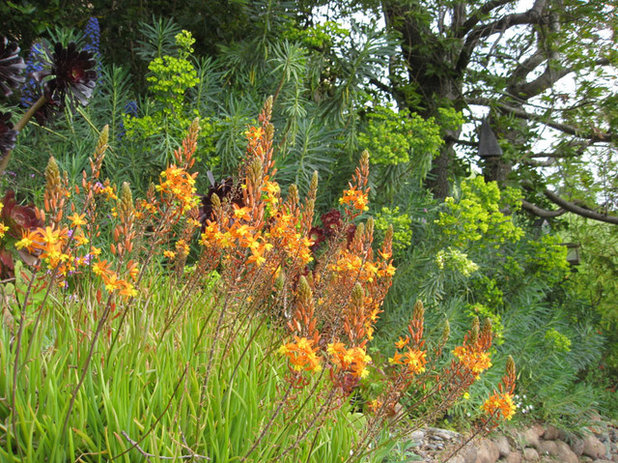
Dig Your Garden Landscape Design
7. Bulbine(
Bulbine frutescens)
Native to South Africa
Spikes of light orange flowers appear on bright green succulent stems, adding a colorful presence to the garden. Blooms can last throughout the year, stopping only in summer in areas that experience hot summers. Frequently used as a ground cover, bulbine has a clumping growth habit that gradually spreads in the landscape, creating a carpet of green topped with lovely orange flowers throughout much of the year.
While bulbine grows best in full sun, it can take light shade, which makes it a suitable choice for planting in areas underneath desert trees such as cascalote (
Caesalpinia cacalaco), palo blanco (
Acacia willardiana) and ‘Desert Museum’ palo verde (
Parkinsonia x ‘Desert Museum’). For color contrast, plant alongside purple flowering plants.
Popular cultivars of bulbine include ‘Hallmark’, shown here, and ‘Tiny Tangerine’, which are both sterile. However, regular orange bulbine can self-seed in the landscape.
Where it will grow: Hardy to 10 degrees Fahrenheit, or minus 12 degrees Celsius (Zone 7)
Water requirement: Water every three to four weeks throughout the year. In low-desert gardens, water every one to two weeks in summer.
Light requirement: Full sun to light shade
Mature size: 1 foot tall and 1 to 2 feet wide
Planting notes: Plant in well-drained soil in full sun to part shade.
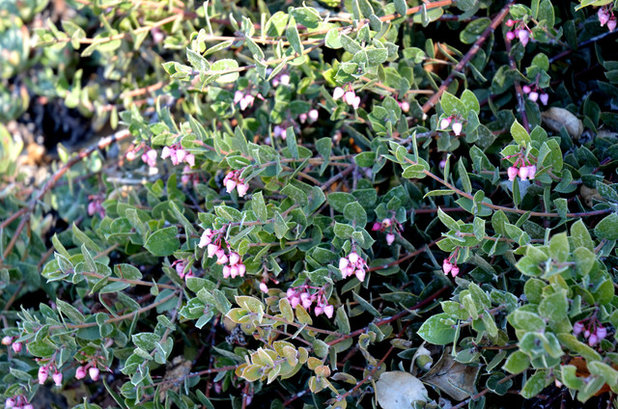
Noelle Johnson Landscape Consulting
8. Manzanita (
Arctostaphylos spp.)
Native to the western half of the United States, including Washington, Oregon, California, Arizona and New Mexico; also found in British Columbia, Canada, and Mexico
Manzanitas are a great drought-tolerant choice for landscapes where warm, dry summers and cool, moist winters are the norm. There is great variability between the species — from ground covers to shrubs to small trees — but regardless of the form it takes, manzanita’s evergreen foliage serves as an attractive backdrop to the flowers that appear in winter and early spring. The flowers and foliage add subtle beauty to the landscape, while manzanita’s mahogany-red bark provides an additional layer of color. There are many species and varieties of manzanita, including 80 found in California alone.
They are suitable for freeway landscaping as well as parking lots and road medians. In the residential landscape, they can be used in the background of a naturally themed yard. Larger species can be maintained as small multitrunked trees serving as a focal point in a garden bed surrounded by ground covers. Lower-growing species are a great choice for planting on slopes.
Where it will grow: Depending on the species, from 0 degrees Fahrenheit, or minus 18 degrees Celsius (Zone 6), and up
Water requirement: Once established, water to a depth of about 1½ to 2 feet. Allow the soil to dry out before watering again.
Light requirement: Full sun to light shade; in inland areas, light shade for best results
Mature size: Variable; 1 to 15 feet tall and wide, depending on the species
Planting notes: Plant in well-drained soil in full sun to part shade.
Shown: ‘Arroyo Cascade’ manzanita (
A. ‘Arroyo Cascade’)
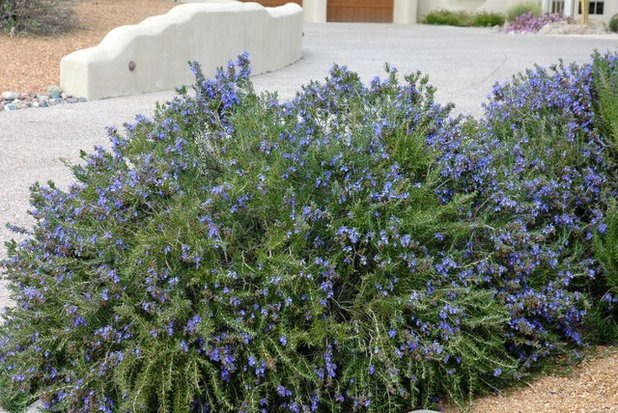
Noelle Johnson Landscape Consulting
9. Rosemary(
Rosmarinus officinalis)
Native to the Mediterranean
While most people think of rosemary as an herb for flavoring their favorite dishes, it’s also well-known as an ornamental landscape plant for those who live in zones 7 and above. The needlelike foliage is aromatic and provides a splash of dark green color to the drought-tolerant landscape. The appearance of blue flowers in winter and spring provides another reason to add this Mediterranean native to the landscape.
Rosemary is quite versatile, as it’s available in both shrub and landscape forms. The shrub form makes a nice formal hedge, topiary and container plant. As a ground cover, rosemary can be used to line a walkway or planted in informal groups of three. Create great color contrast by pairing it with angelita daisy (
Tetraneuris acaulis), bush morning glory (
Convolvulus cneorum) or damianita (
Chrysactinia mexicana).
Where it will grow: Hardy to 10 degrees Fahrenheit, or minus 12 degrees Celsius (Zone 7; some varieties OK in Zone 6)
Water requirement: Water every three to four weeks spring through fall. In winter, rely on rainfall. In low-desert areas, water every two weeks spring through fall and every three weeks in winter.
Light requirement: Full sun
Mature size: Shrub form, 2 to 3 feet tall and wide; ground cover, 2 feet tall and 6 feet wide
Planting notes: Plant in well-drained soil in full sun.
See how to grow rosemary
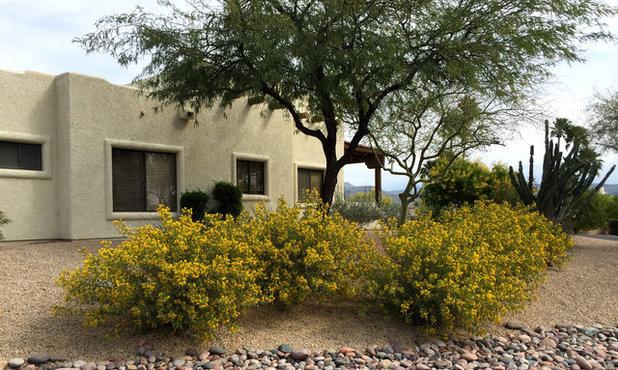
Noelle Johnson Landscape Consulting
10. Outback Cassia(
Senna artemisioides ssp.
oliogophylla)
Native to Australia
With their golden-yellow flowers that appear in late winter into spring, cassia shrubs are a welcome addition to the plant palette of landscapes that experience hot, dry summers. Outback cassia resembles manzanita in that its attractive green foliage and reddish stems offer nice color contrast when not in flower. The gray-green leaves of this cassia species visually soften the landscape.
Plant outback cassia near drought-tolerant plants with contrasting red-colored blooms, such as chuparosa (
Justicia californica), firecracker penstemon (
Penstemon eatonii) and Valentine bush (
Eremophila maculata ‘Valentine’), to make the most of its flowering season. For a colorful landscape year-round, add summer- and fall-flowering plants like Baja fairy duster (
Calliandra californica), ‘Blue Bells’ (
E. hygrophana ‘Blue Bells’) and Texas ranger (
Leucophyllum frutescens), which lend interest to the landscape when outback cassia isn’t blooming. Like most cassia species, this one thrives in hot, reflected heat. It’s suitable for west-facing exposures as well as street and parking medians.
Reddish-brown seedpods appear after flowering, which can be pruned away in late spring to keep them from reseeding.
Where it will grow: Hardy to 20 degrees Fahrenheit, or minus 7 degrees Celsius (Zone 9)
Water requirement: Water once a week in summer, every two weeks in spring and fall, and monthly in winter.
Light requirement: Full sun
Mature size: 5 feet tall and wide
Planting notes: Plant in well-drained soil in full sun.





